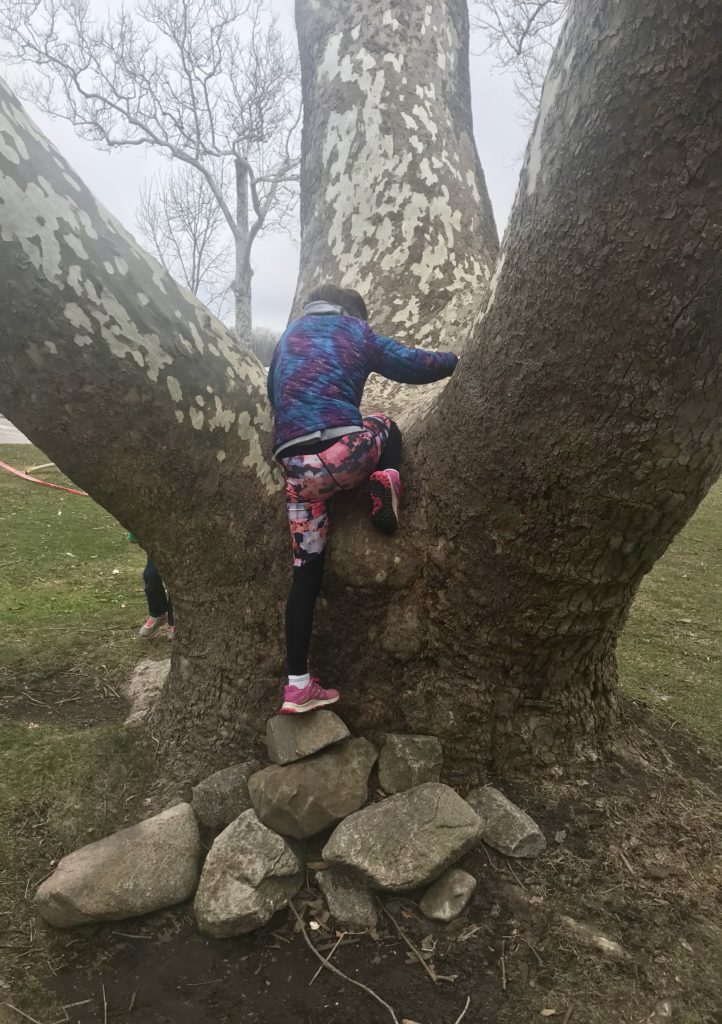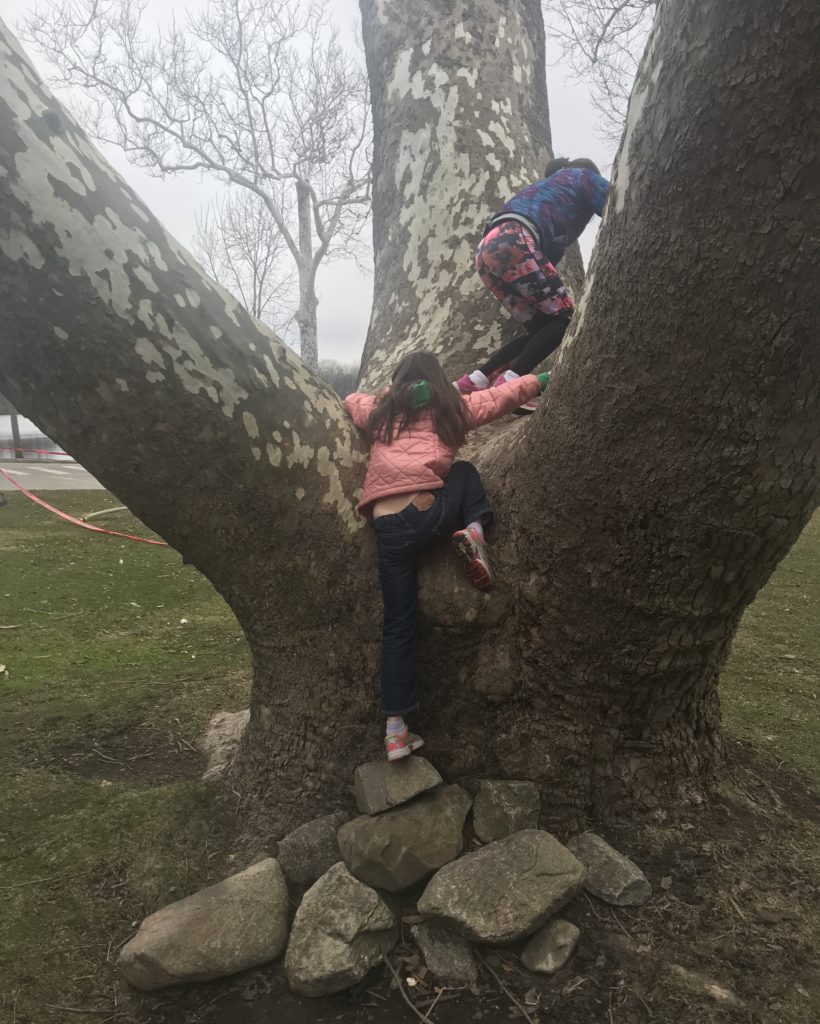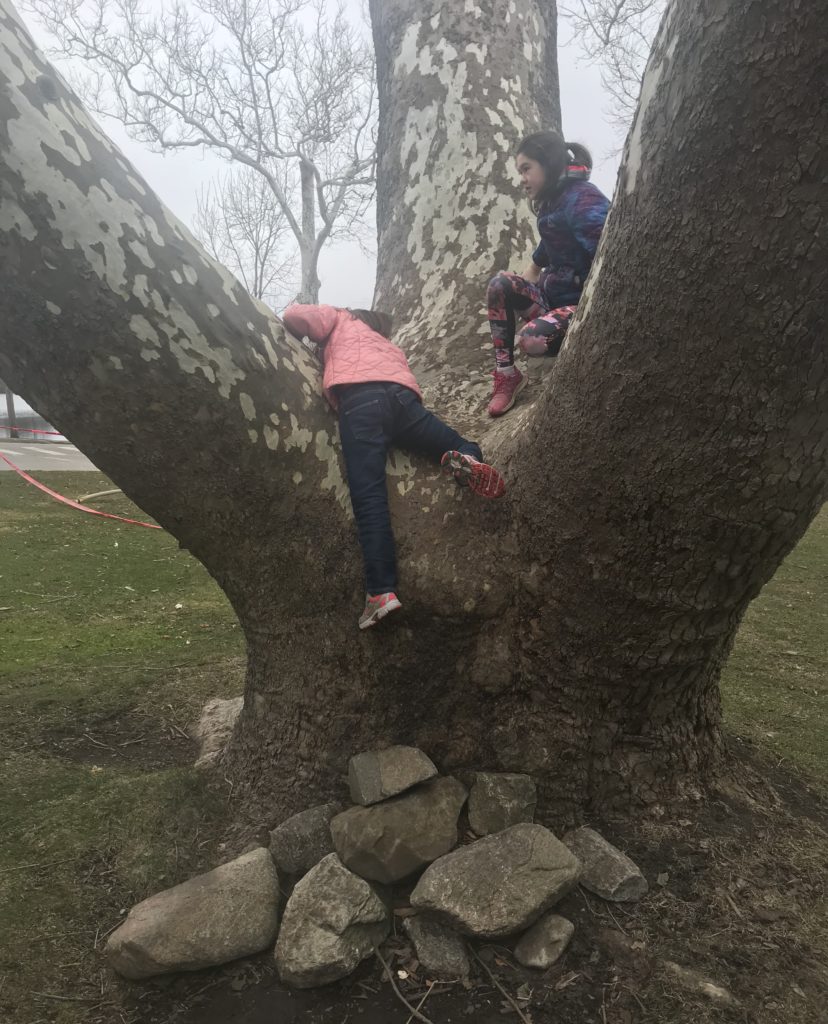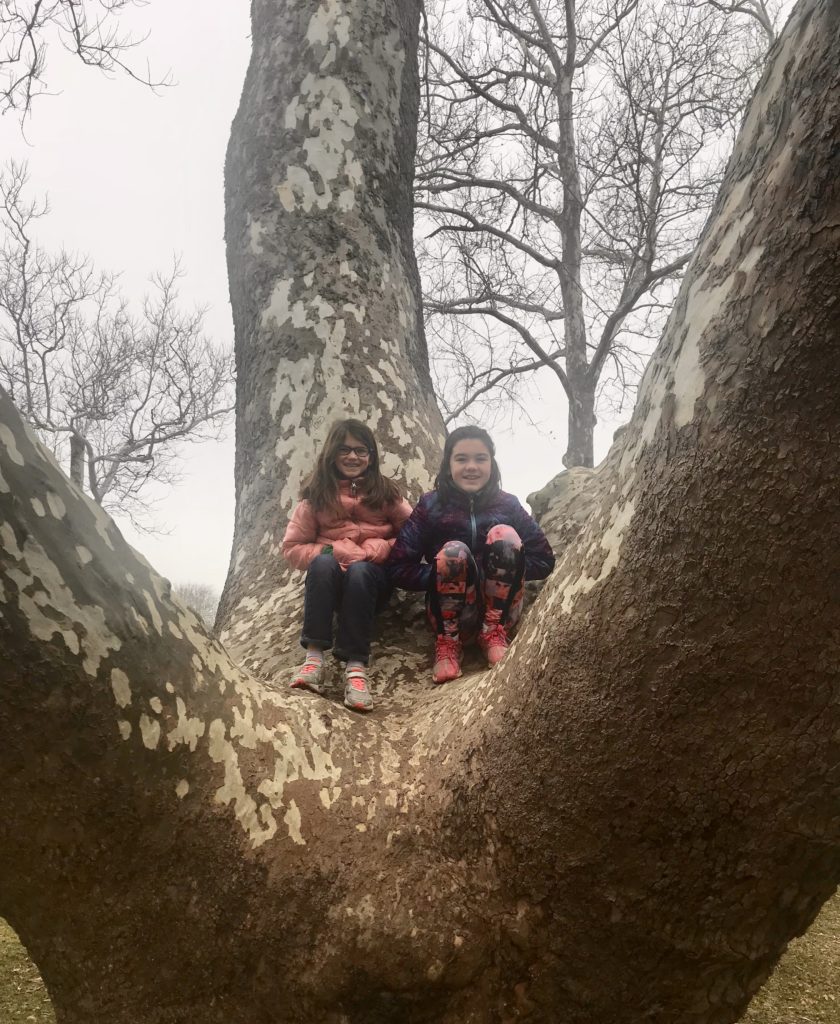Last month when we were at Notre Dame, Hadley and Harper found a grand old tree, that was perfect for sitting in. However, the first spot to heft oneself up was about four feet from the ground. Plus, the tree seemed to be balding – its bark chipped off and a smooth, white surface made it difficult, I assume, to climb further.
The tree reminded me of the sycamore grove Romeo walks through outside Verona’s city limits in the middle of the night mourning the fact Rosalie does not love him. I remember thinking how clever Shakespeare was to use a tree’s species to get at how Romeo is feeling. (“Love sick? Get it?” I’d say to my students.) Studying the scene more though, I found details that I think got at a person’s plight into adolescence: the grove is just on the edge of town, close enough to home, but far enough to be alone for a time. I also learned that when a sycamore tree’s bark is peeling off, that the tree is most alive. It seems a person figuring out the world and their place in it, realizing things are not always as they seem; that we are not always as we seem, would find comfort knowing that times when we feel alone (when we want to be alone), times when we feel vulnerable, are also times when we are growing and changing. To be confused and weary, vulnerable and unsure means we are alive.
Several rocks were piled up against the tree, and Hadley and Harper stepped on those to get to the sitting spot. I suppose I felt sentimental, but I liked the idea that college students were looking out for other college students, piling up these rocks so others could climb. Maybe those stones were there for the kids who just started college, but were dreaming and thinking (wishing?) they’d like to go home, and the older kids put rocks here to help – “I’ve been here, too. I know. Take a break, and climb a sycamore. Be lovesick. Be homesick. And then get back to it.”
No matter who it was, somebody put those rocks there to help somebody else climb, and it made me happy knowing we are able to look out for each other. We can show each other things about the world we think are great or special or might just allow some reprieve for a bit.
This tree doesn’t stand in the heart of campus. It’s a few paces from the Grotto – a place that, judging from the always lit candles representing prayers prayed, is highly visited, but it’s quiet and out of the way. Like the grove Romeo walked through, I’ve always thought people came to this part of campus with heavier hearts, heftier thoughts, and a need to be alone and sit a while with our confusion and sorrow and mysteries.
As a parent, this is a hard concept for me to accept. It was a difficult concept for Romeo’s father, too. When Benvolio tells him about Romeo’s walk through the woods, his dad tells Benvolio that he wished Romeo would snap out of this mood, or talk to him about it. Maybe he could help him out.
I think Romeo’s dad means what he says, but I also think he’s uncomfortable because his son is uncomfortable. What’s more, while he might be able to say, “I’ve been there, I know,” it is Romeo that must go through this now. It makes no difference who’s gone through it before – we all must figure it out for ourselves.
It’s all fiction, I know. And this tree at Notre Dame might not be a sycamore. I suppose it’s easy to brush all of this off, except I know about wanting some space to think, and to sort a few things out. Even at 42, I understand wanting to be far enough from home to spread my wings, while at the same time knowing how to get back home, where I am loved, accepted, and safe.
I also understand the trepidation in watching my child walk among the sycamores. I know how it feels to watch my kid attempt to climb knowing she could fall, or perhaps worse, never figure out how to climb at all.
The story might not be true, but I am glad for what’s been made up because it helps me walk with what’s true.
On Friday, a group of students, including Hadley and Harper, will walk-out of their school to honor the many lives lost in school shootings, and to voice their hope that this will stop. Here’s a video giving more information about what’s happening.
I think it’s a bold move. As an educator, I am worried about the disruption this might cause. As a mother, I am worried this is too much for my kids to process, and to be responsible for. As a human being, I am overwhelmed and scared, and I am sad.
So I guess that’s why I’ve turned to Shakespeare and the sycamores. Trudging through the language, trying to understand a story that is so sad, putting myself in both Romeo’s and his father’s place, helps me realize that we can be confused and bold. We can be scared and convicted. We can be sad, and we can take a stand.
Hadley and Harper will have their own stories for this experience they’ll participate in on Friday, and I hope this won’t be the last time they make an attempt to stand up for what they believe in. I also hope that on Friday and on all the days they grow up in Ann Arbor, that they will see the stones that their village piled for them to step on. I hope they understand that, like the peeling bark of the sycamore trees, layers start to come off revealing something fresh and new and raw and fully alive, and that growing up and trying is hard, beautiful work.
Hadley was afraid to jump down, and asked me to help her down from the tree, so I stepped forward, reached my arms up, and guided her down the trunk. “Thanks, Mom,” she said, walking towards the stones. “You mind if I try again?” she asked. “I want to try to get down by myself this time.”
I took a few steps back to show I wouldn’t intervene. I put my hands in my pockets and watched as my girls climbed and jumped, climbed and jumped on the last days of winter, murky and cold. I wondered when the sun would come out for good, warming the earth so what’s alive could bloom, and what blooms would change the world.





Leave a Reply